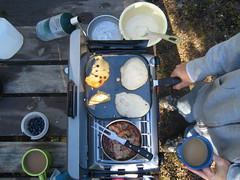Safety is, and should be, your first concern when camping. All the planning and excitement for a fun-filled camping experience won't do you any good if it's all ruined because of an unpleasant experience, or worse.
| (Photo credit: Wikipedia) |
How does food storage affect your safety at a camp site?
1. Food poisoning – cases are reported every year of campers suffering from illness and actual food poisoning due to improperly cooked or improperly stored food.
2. Wild animal attacks – although rare, cases of attacks due to an animal being startled while foraging for food are still reported.
As you can see, food storage accounts for several safety issues. Let's take a look at some tips and tricks for how to safely store food when camping.
The Cold Food
Choose a cooler that will safely accommodate your food and keep it cold. Placing frozen bottles of water inside of your cooler will keep your food and the cooler colder for a longer period of time, and you can drink the water. Freeze any meat that you won't be using the first day in camp. This will allow it to thaw inside of the cooler and cut down on the chances of it spoiling before you use it. It will also act as an ice block to keep everything inside the cooler cold. Think of it this way; a frozen block of ice takes up room and doesn't feed anybody, whereas a frozen slab of bacon, meat, or fish does double duty.
The Nonperishable Food
Store your nonperishable food items in plastic containers with airtight lids. This will keep your food items safe from weather, bugs, and larger hungry critters, and will also keep everything together in one place. Bread, cookies, and other dry food items should be kept in one container, tightly sealed. Other heavier items, like fruit, should be kept together in a separate airtight container. You don't want your grapefruit rolling around on top of your bread. And, yes, keep your canned goods in this same manner. Even though critters won't get into a can, if it rains, you won't lose the labels and end up with 'surprise soup' for dinner.
| Camping Breakfast Day Two (Photo credit: Simply Bike) |
Place your cooking items such as pots, eating and cooking utensils, plates and cups in several plastic containers with snap on lids. This way you'll have everything in one place when you need to find it. By storing them in the container, you'll keep everything clean when you go to use it again. The plastic containers also double as wash up stations, which is another important safety consideration. You don't want to leave dirty food-covered utensils sitting around.
Safeguard Containers For Car Campers
Place your food storage container and cooler inside of your car before you crawl into your tent at night. Critters such as raccoons and squirrels are quite resourceful and will figure out how to open or chew through almost anything holding food. If you're in bear country, you may just wake up and find entire containers missing. And never, ever, ever store your food inside of your tent.
Safeguard Containers For Hikers
If you are hiking into your campsite, you won't have your car to store your food containers. Instead, you'll need to put your sealed food containers into sacks and hoist them up in a tree. Your goal is to keep them out of reach of any animals, such as bears, that may be attracted to your food. Make sure you still put your foods in airtight containers so an animal is less likely to smell anything tasty. Then be sure to hoist the bags up in a tree at least 50 yards away from camp. Do this on day one because if an animal gets even one treat from you, they will be back for another, even if you have safeguarded it.
Planning for food safety for your camping trip takes a bit of work, but it's worth it. Food cooked over a campfire under the stars somehow makes everything taste better. Keep your food, and your family, safe with these simple food storage tips, and enjoy the great outdoors! And be sure to check back later this week for some tasty campfire recipes!



No comments:
Post a Comment
We welcome comments and suggestions!